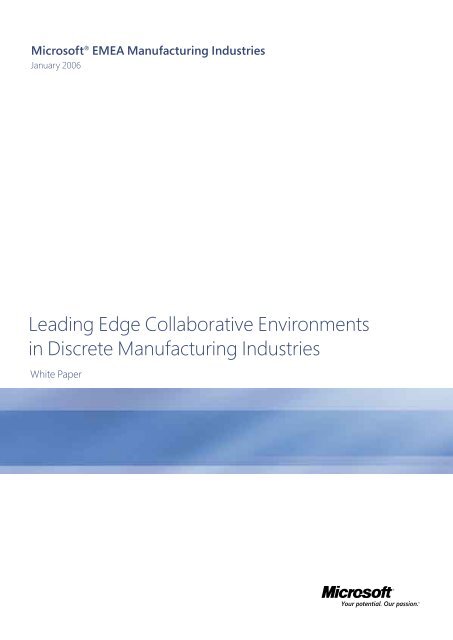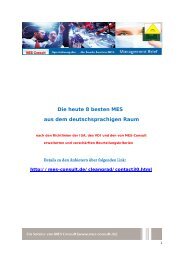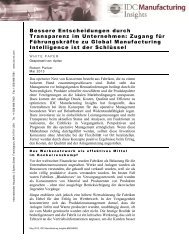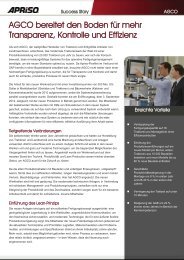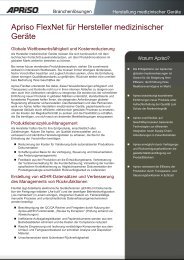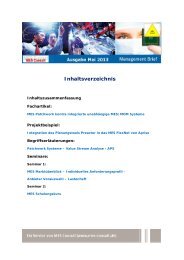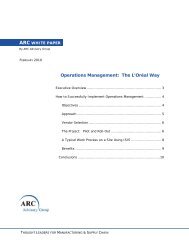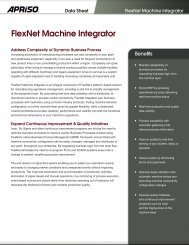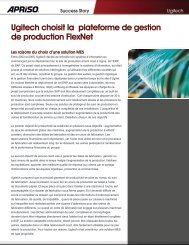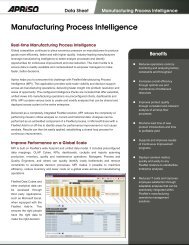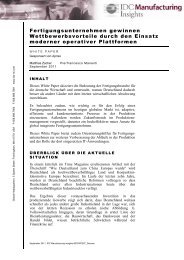Collaboration - Apriso
Collaboration - Apriso
Collaboration - Apriso
You also want an ePaper? Increase the reach of your titles
YUMPU automatically turns print PDFs into web optimized ePapers that Google loves.
Microsoft ® EMEA Manufacturing Industries<br />
January 2006<br />
Leading Edge Collaborative Environments<br />
in Discrete Manufacturing Industries<br />
White Paper
Working better is one of the main goals of every company.<br />
Working together is the way to achieve this. Internally or with<br />
business partners, seamless access to relevant information,<br />
transfer and sharing documents, automation of manual tasks to<br />
accelerate processes are examples of collaboration.<br />
<strong>Collaboration</strong> tasks are a condition for lean transformations,<br />
management by exception, innovation, cost reduction,<br />
operational performance and success.<br />
This white paper is designed for business leaders of<br />
manufacturing companies who wish to explore the role of state<br />
of the art collaborative environments in delivering competitive<br />
advantage, and the approach to Information and<br />
Communication Technology (ICT) that delivers efficient, flexible<br />
support for collaborative solutions.<br />
2<br />
Thank you to partners<br />
Microsoft would like to offer its thanks to the following<br />
people and organisations for contributing to and assisting<br />
in the production of this white paper:<br />
<strong>Apriso</strong> Corporation<br />
CoCreate Software, Inc<br />
Dassault Systemes<br />
Manhattan Associates<br />
Red Prairie Corporation<br />
Siemens<br />
UGS<br />
Wonderware, Invensys<br />
LEADING EDGE COLL ABORATIVE ENVIRONMENTS IN DISCRETE MANUFACTURING INDUSTRIES
Contents<br />
Introduction 4<br />
World Class Manufacturing in the 21st Century 5<br />
<strong>Collaboration</strong> 7<br />
Understanding and Applying Collaborative Environments 9<br />
Collaborative Environments in Design and Engineering 11<br />
Collaborative Environments in Manufacturing Operations 16<br />
Collaborative Environments in Warehousing, Distribution and Logistics 19<br />
Information and Communication Technology for Collaborative Environments 22<br />
Conclusion 26<br />
LEADING EDGE COLL ABORATIVE ENVIRONMENTS IN DISCRETE MANUFACTURING INDUSTRIES<br />
3
4<br />
Introduction<br />
Leading manufacturing companies have found a new source of competitive advantage. It is collaboration.<br />
<strong>Collaboration</strong> helps companies act quickly and accurately, make decisions, assign tasks, and execute<br />
business processes. <strong>Collaboration</strong> opens up new ways of working and drives innovation. <strong>Collaboration</strong> has<br />
become an engine of productivity and an essential core competence.<br />
A company with strong collaboration capabilities can improve both operational performance and<br />
strategic development. In operations, collaboration capabilities catalyse innovation and help networks<br />
of in-house teams, suppliers and channel partners to act efficiently, flexibly, and quickly. For strategic<br />
development, the ability to collaborate gives business leaders freedom and confidence to initiate a wider<br />
range of strategies, including all types of outsourcing, and the full range of risk-reward sharing options in<br />
partner relationships.<br />
At Microsoft, we and our partners are providing all of the advantages of collaboration, while allowing users<br />
to move between applications and information easily. Our tools empower users in collaborative<br />
environments irrespective of the devices they use – even when temporarily disconnected from a network.<br />
The basis for our vision is an architecture that follows three guiding principles:<br />
Current Business Challenges<br />
Increasing<br />
employee<br />
responsiveness<br />
Keeping everyone<br />
on the<br />
same page<br />
Industry<br />
leadership<br />
Customer<br />
connection<br />
Business Performance<br />
Revenue<br />
Effective collaboration<br />
required<br />
Leveraging<br />
customer<br />
information<br />
growth Talent pipline/<br />
management<br />
Innovation<br />
Business Investment<br />
Operational Excellency<br />
Process<br />
excellence<br />
Business Objectives<br />
Leveraging information<br />
and systems<br />
Governance<br />
Competitive<br />
agility<br />
Service-Orientation: tool specialisation is vital, but a tool’s services must be readily accessible from<br />
another application.<br />
Open and Standards-based: data formats and protocols must be open and based on standards<br />
where they apply.<br />
Accessibility: tools and information must be readily accessible by any authorised user, inside or outside a<br />
business, connected or disconnected from a network, using any suitable device.<br />
Microsoft technology adheres to these principles, maintains freedom to deploy all leading applications,<br />
and provides the capability to deploy them in collaborative environments.<br />
LEADING EDGE COLL ABORATIVE ENVIRONMENTS IN DISCRETE MANUFACTURING INDUSTRIES<br />
Sharing best<br />
pactices,<br />
assuring<br />
continuity<br />
Overcoming<br />
organisational<br />
and geographic<br />
barriers<br />
Managing customer<br />
and partner<br />
ecosystem
Collaborative environments help people connect to colleagues, customers, and partners using<br />
innovative Information and Communication Technology (ICT). To understand their importance and<br />
potential, this document discusses:<br />
• Issues driving growth in the business value of collaboration;<br />
• The types of collaboration important to most manufacturers;<br />
• Solution types and the collaborative environments created by leading application software designers;<br />
How to create integrated ICT platforms for collaborative environments.<br />
•<br />
World Class Manufacturing in the 21 st Century<br />
Today’s manufacturing businesses face more opportunities, threats, and change than ever. Businesses<br />
must be more efficient, agile, and competitive because:<br />
Global markets: are more accessible. New competitors bring new technologies and new approaches<br />
to market. They compete for the same customers and offer new products, new services, and new<br />
brand values.<br />
Customers: are well informed so regional premium pricing is no longer sustainable. Also, although<br />
demand remains price-sensitive, excellence is routinely achieved by most manufacturers so cannot be<br />
a differentiator.<br />
Products: are becoming more capable, complex, and configurable.<br />
Regulations: create increasingly demanding frameworks for business processes – from material handling<br />
to audit trails and financial reporting.<br />
Corporate strategies: have developed beyond mergers and acquisitions (M&A) of competitors, suppliers<br />
and distributors. Now, leading companies actively plan and manage M&A activities to achieve integrated<br />
product, service, and brand differentiators, as well as revenue, margin, and profit goals.<br />
These pressures force manufacturers to implement strategies such as those shown below to improve<br />
performance in every business area. Customer-focused responsiveness has joined quality, efficiency,<br />
regulatory compliance, and cost control on the ‘must-do’ list of every manufacturer.<br />
Typical Manufacturers’ Strategies<br />
Create small, decentralised decision-making units, often within an enterprise; sometimes involving<br />
divestments and outsourcing.<br />
Become customer-centric. ‘Product-push’ has largely been replaced by ‘customer-pull’. Manufacturers<br />
build product on order, convert product offers into attractive solutions with strategies such as pay-per-use.<br />
Manage the value network to enhance customer experience. In both consumer and business-to-business<br />
environments, the customer experience depends on every touch-point with every partner.<br />
Enhance responsiveness and quality of operations with lean manufacturing, just-in-time, Six-Sigma, and<br />
traceability initiatives.<br />
Outsource to reduce cost, increase flexibility, and focus on core competence. Require suppliers to take<br />
more responsibility, for example, through risk-sharing.<br />
Manage activities as projects, not independent steady-state functions. Activities in a single project may<br />
span multiple departments and companies.<br />
LEADING EDGE COLL ABORATIVE ENVIRONMENTS IN DISCRETE MANUFACTURING INDUSTRIES<br />
5
6<br />
These strategies may involve new technologies, structures, partnerships, and commercial conditions.<br />
To be successful, it is necessary to work as part of a network and collaborate across all disciplines both<br />
in-house and with partners. Engineering, sourcing, procurement, supply chain, production, sales,<br />
marketing, distribution and service must share information and expertise. Good collaboration creates<br />
value because it allows the speed, flexibility, and holistic view of small decision-making units combined<br />
with the quality and efficiency of a connected network.<br />
Collaborate to co-ordinate<br />
Imagine a supply chain incident – a supplier mixed up deliveries between two sites. Moving<br />
materials between sites will take 48 hours, but they are needed for a customer order scheduled<br />
for production tomorrow. Is it possible to fulfil the order and maintain workloads at both sites?<br />
ERP scheduling shows a solution – but it involves delay to other orders, and planners need more<br />
information. Does the ERP materials information match reality? How critical are the orders<br />
according to sales? What is the impact of paying premium prices for materials from an<br />
alternative supplier today?<br />
Planners would use a collaborative environment to: review real inventory and shop-floor status;<br />
discuss priorities with sales and customers; negotiate with suppliers; and quickly implement a<br />
new optimal plan.<br />
Collaborate to sell<br />
Imagine the situation: a sales rep calls the office to report a meeting with a portable machinery<br />
manufacturer. “They love our technology, but they’ve rejected our offer because they want to<br />
use their existing supplier’s power management systems and get an integrated unit. We could<br />
do that, but it needs engineering. What shall we do?”<br />
Leading companies recognise that the way to win orders is to work with customers and,<br />
potentially, customers’ suppliers. This requires collaboration involving design, procurement,<br />
manufacturing, distribution and sales – in-house and throughout the supply chain.<br />
Collaborate to innovate<br />
In the old design office, team leaders, the chief engineer and office manager could walk around<br />
the room, get an impression of progress, discuss ideas, and explain new concepts.<br />
Early CAD systems offered productivity, quality, re-use and standardisation benefits, but small<br />
screen sizes and controlled environments worked against ad-hoc communication and big<br />
picture collaboration.<br />
Now, collaborative CAD environments can create the equivalent of a meeting around the<br />
drawing board – bringing together, say, electronic designers in Asia, functional designers and<br />
ergonomics specialists in Europe, and engineers representing contract manufacturers.<br />
Conditions to trigger innovation remain hard to define, but collaborative multi-disciplinary<br />
communication is a great start. A continuous stream of incremental innovations can be as<br />
valuable as a single big new concept.<br />
LEADING EDGE COLL ABORATIVE ENVIRONMENTS IN DISCRETE MANUFACTURING INDUSTRIES
<strong>Collaboration</strong><br />
For manufacturers, today’s drivers of change are not so much automation as handling the vast amount of<br />
information. ICT systems make the right information available at the right time,<br />
in the right place, in the right context and format to help ensure the right decisions are made.<br />
In business, we work with others to get jobs done, so why isn’t collaboration a basic attribute of software?<br />
One reason is that tools have evolved in isolation – each focused on a narrow group of activities – and it’s<br />
not easy to move between them with the information we need. Another is that our tools may be accessible<br />
only to people within company boundaries, or may not permit us to work while travelling, or otherwise<br />
disconnected from the corporate network.<br />
The Microsoft collaboration vision is about providing software and services that deliver pervasive<br />
capabilities to help people and applications to work together. Microsoft has emerged as a leader in<br />
collaboration services because of its 30-year history of understanding end-user needs, best-of-breed<br />
productivity applications, proven infrastructure-level integration, extensive partner and developer<br />
ecosystem, and commitment to standards-based interoperability.<br />
Providing authorised employees and partners with appropriate views of aggregated, consolidated,<br />
accurate, up-to-date status and plans is a powerful vision: people and systems then act on consistent<br />
information throughout. But shared information is not the complete solution: collaboration is also needed<br />
to ensure rapid response to inevitable changes in customer and market requirements.<br />
<strong>Collaboration</strong> Has Its Own Challenges<br />
Changing work climate driving new challenges<br />
Email<br />
Communication<br />
requests<br />
Information<br />
growth<br />
Email overload<br />
Teaming Working together is difficult<br />
Events demand real time access to expertise<br />
Finding information and people is time consuming<br />
Teaming Data is disconnected from process and projects<br />
LEADING EDGE COLL ABORATIVE ENVIRONMENTS IN DISCRETE MANUFACTURING INDUSTRIES<br />
7
8<br />
A Collaborative Environment:<br />
• Offers more than simple information sharing.<br />
It helps a team of people and systems to work together efficiently. The team may be in-house,<br />
or spread across several companies. The environment ensures that all are using the right<br />
information to execute tasks, make decisions, and communicate actions.<br />
• Provides user-friendly access to unified, integrated, real-time business data.<br />
No more delays waiting for answers from departmental data silos. No more conflicting<br />
information sources.<br />
• Facilitates discussion and action by the group involved. E-mail, instant messaging, shared<br />
Web sites, online conferencing all help individuals, departments and companies to work<br />
effectively together.<br />
• Breaks down geographical and organisational barriers, and helps companies and their partners<br />
to operate as a single cohesive unit.<br />
• Supports automation.<br />
• Not all collaboration involves people. Where it is possible to automate, for example, actions<br />
triggered by standard conditions, then the environment facilitates information exchange.<br />
There are three types of collaboration in manufacturing businesses. All can now be performed online,<br />
independently of the location of the parties involved:<br />
Automation: information from one or more parts of the value chain is collected, processed, and used by<br />
another, without manual intervention. For example, information about a factory’s stock and its production<br />
status and plans could be used by suppliers to automate decisions about deliveries.<br />
Planned collaboration: a business process may require two or more groups to share information and<br />
work together. For example, formal sign-off of a project milestone usually requires stakeholders to share<br />
and discuss project status information.<br />
Ad-hoc collaboration: individuals or a group need information from another part of the value chain; or<br />
have to refer a situation to another part of the value chain. Immediate communication and data sharing<br />
enures that situations are resolved or escalated rapidly.<br />
In a collaborative environment, businesses get complete clean, aggregated, timely data covering<br />
suppliers, customers and in-house activities – available to all employees at the right time, in the right<br />
context. Alerts and automation reduce or eliminate routine tasks. Online discussion and data sharing<br />
mean immediate resolution of uncertainties as well as consensus decision making across geographic and<br />
organisational boundaries.<br />
Imagine the possibilities. Operators, managers and executives gain insight into business processes – of<br />
their own company and those of trading partners. Quick decisions, immediate responses, actions to<br />
improve performance, all co-ordinated with suppliers and customers, become the norm. The stage is set<br />
for dramatic change from average to excellent.<br />
LEADING EDGE COLL ABORATIVE ENVIRONMENTS IN DISCRETE MANUFACTURING INDUSTRIES
Understanding and Applying Collaborative<br />
Environments<br />
New technology is sweeping away the barriers that encouraged information silos.<br />
There was a time when access to data was restricted to the users of the application that created and<br />
managed it. Even database sharing was limited to modules from a specific application vendor. So there<br />
were few options to share data along the value chain. The options that existed had limited capabilities –<br />
for example, print and distribute a report; or output data in a format that another application could use.<br />
Now, the situation has changed. The Microsoft vision and architecture provide easy-to-use tools that<br />
empower application developers to:<br />
•<br />
Value Chains in Manufacturing Networks<br />
Suppliers<br />
Demand<br />
Specification<br />
Suppliers<br />
Purchasing<br />
Eliminate information silos;<br />
Control and manage information access;<br />
Deliver information when and where it is needed.<br />
Manufacturing Sales &<br />
Customer<br />
Distribution<br />
Engineering<br />
Products<br />
Design<br />
Demand<br />
Products<br />
Using Microsoft technologies, application developers can create open collaborative environments and<br />
facilitate communication, group working, and quick response.<br />
Collaborative environments support interactions within a function, between functions and spanning large<br />
parts of the business network. In addition, people – from the production supervisor to chief executive – can<br />
gather information, gain insights, plan initiatives, and implement actions without barriers.<br />
To satisfy user needs, a collaborative environment must offer a familiar interface. A Web browser can<br />
access a portal configured to bring together the right information. But also, since most collaborators use<br />
Microsoft Office, application developers can extend the range of people that benefit from their output by<br />
using its integration options.<br />
For example, engineering applications have for years offered interfaces that integrate with Microsoft<br />
Office Excel spreadsheet software. Now, the range of data that can be interrogated and updated from<br />
Office is growing: from enterprise applications to productivity tools, integration with Office is ensuring<br />
ease of use and deployment.<br />
LEADING EDGE COLL ABORATIVE ENVIRONMENTS IN DISCRETE MANUFACTURING INDUSTRIES<br />
9
10<br />
For example, Microsoft partners now integrate 3D data into Office documents, including:<br />
•<br />
Structured images in Microsoft Word that can be clicked to select component information;<br />
Calculated properties (e.g. material volume, or calculated price) in Excel;<br />
Embedded 3D data in Microsoft Office PowerPoint presentation graphics program.<br />
Engineering Applications and Office Systems<br />
Microsoft partners have created many opportunities to embed engineering data into Microsoft Office<br />
documents. Examples include Autodesk’s DWF Viewer, Dassault’s 3D XML Player, UGS’s JT2Go 3D viewer,<br />
Actify’s Spinfire, and Lattice3D’s XVL player. These can deliver tight integration between engineering<br />
applications and Microsoft Office documents, allowing 3D data to be harnessed across the enterprise.<br />
One example of integration with Microsoft Office is based on 3D XML:<br />
“ Using the 3D XML documentation and tools available freely at www.3ds.com/3dxml, Powerway<br />
added 3D capabilities into its existing industry-leading product, Powerway.com. Then, working<br />
with Microsoft, it developed a demonstration that tied together real-time product data that<br />
management, engineering and suppliers could access to solve the problems, quickly and<br />
collaboratively, by seeing them in 3D via their existing applications, such as Microsoft Office.<br />
The new application requires no additional learning by existing users.”<br />
(Source: Dassault Systèmes 29 August 2005, Detroit, MI, USA)<br />
But business systems also offer this integration, often by giving access to their data from inside Office<br />
applications. These help create collaborative environments that can reach everybody who adds value to a<br />
product, project or service. Familiar environments make it easy for users to access data from a range of<br />
applications, which encourages the use of shared information sources that in turn improve consistency of<br />
information across departments and trading partners.<br />
The result is growth in the opportunity for, and the value of, collaborative environments for many job<br />
functions (see panel below).<br />
Using a collaborative environment<br />
A collaborative environment has value for virtually every employee in a manufacturing company, from the<br />
boardroom to the plant floor.<br />
An Engineering Manager will use a collaborative environment to share realtime technical information,<br />
investigate technical and project issues, run review meetings and progress initiatives. The environment<br />
will allow the manager to communicate with colleagues and partners to solve problems, make decisions,<br />
and approve action.<br />
A Logistics Manager will use a desktop display of ‘traffic lights’ showing aggregated real-time information<br />
covering production, stock levels and distribution events, with drill-downs. The manager may use it in a<br />
planned manner to review and approve plans, and equally – perhaps, when investigating an ‘amber’<br />
condition – to initiate ad-hoc collaboration to get more details. While travelling, the manager may switch on<br />
text message alerts.<br />
A Purchasing Administrator may access goods-received data and initiate ad-hoc collaborative sessions with<br />
managers who requested purchases to complete authorisation. Their discussions will be supported by<br />
immediate desktop or remote access to consistent, up-to-date information.<br />
A Production Manager may find the main use of a collaborative environment is to discuss changes with<br />
colleagues. Sales may want to push certain orders through. Engineering design may want to delay a planned<br />
manufacturing change until a customer agrees the prototype. Purchasing may suggest the use of substitute<br />
materials. A partner that provides a specialist finishing process may want to agree best dates for machine<br />
maintenance. In each case, the interaction can be on the basis of accurate, shared information – meaning<br />
fast decisions.<br />
LEADING EDGE COLL ABORATIVE ENVIRONMENTS IN DISCRETE MANUFACTURING INDUSTRIES
Collaborative Environments in Design<br />
and Engineering<br />
CoCreate (www.cocreate.com)<br />
“ We can fire-up an online meeting in seconds. Our distributed teams can approach OneSpace.<br />
net meetings just like stopping by the desk of a local team member to ask a quick question.”<br />
(Source: Mechanical Engineering Manager of a OneSpace.net user company)<br />
CoCreate’s OneSpace.net is designed to solved the complexities and challenges that product<br />
development engineers face when working with teams that extend across a company and into partner<br />
companies. OneSpace.net is built on the Microsoft environment and makes use of the Microsoft .NET<br />
Framework to offer Web-based, multi-party 3D CAD model design reviews, with the ability to synchronise<br />
dates and tasks with Microsoft Outlook, and maintain traceability of actions across the extended team.<br />
CoCreate offers real-time collaboration to help users speed up whole sequences of activities. For example,<br />
a real-time collaborative session can replace a sequence such as checking out a dataset, e-mailing it to a<br />
colleague, agreeing and making some changes – perhaps by telephone – then checking the dataset back<br />
in to the master database. By exposing selected data from application systems such as ERP, workflow and<br />
version management tools, OneSpace.net connects collaborative sessions to the formal controls<br />
appropriate for design review and follow-through of issues.<br />
The use of Web services architecture inside OneSpace.net has provided an efficient structure for<br />
CoCreate’s software engineers. However, it is the use of the XML standard for data, together with<br />
Microsoft BizTalk Server, that has made a real difference to users. With BizTalk Server, not only are<br />
multiple point-to-point integrations replaced by a single integration to BizTalk Server, but also, it is<br />
possible to build certain business rules into BizTalk Server configurations rather than application code.<br />
“ By basing our development on the .NET Framework we made some aspects of design<br />
collaboration possible that five years ago were simply unthinkable.”<br />
(Source: CoCreate)<br />
LEADING EDGE COLL ABORATIVE ENVIRONMENTS IN DISCRETE MANUFACTURING INDUSTRIES<br />
11
12<br />
The Falcon 7X was entirely<br />
developed in a virtual<br />
environment, from design to<br />
manufacturing to<br />
maintenance. “We created<br />
the virtual platform to work<br />
as though we were on a<br />
physical platform, and to<br />
share a common database<br />
among our 27 partners<br />
around the world in near<br />
real-time.”<br />
Jacque Pellas, CIO,<br />
Dassault Aviation.<br />
Just one year after<br />
implementing this virtual<br />
product development<br />
environment, Dassault<br />
Aviation was able to halve<br />
the time required to<br />
assemble its new Falcon 7X<br />
business jet thanks to the<br />
Dassault Systemes PLM<br />
solutions.<br />
Source: Dassault Systèmes<br />
Collaborative Environments in Design<br />
and Engineering continued<br />
Dassault Systèmes (www.3ds.com)<br />
Dassault Systèmes is a major global vendor of product lifecycle management (PLM) solutions.<br />
DS’s approach to creation of collaborative environments makes use of five principles:<br />
• A common “product, process and resource” (PPR) model shared by all DS PLM solutions and accessed<br />
by collaborating partners;<br />
• Collaborative workspace;<br />
• Industry specific business process optimisation;<br />
• Knowledge management, with multiple levels of access rights to manage and share Intellectual property;<br />
• Openness – enabling extension of the DS PLM platform with applications provided by DS partners. For<br />
example, integration of sourcing information throughout the product lifecycle involves integrating<br />
supplier relationship management (SRM) data.<br />
A key trend, especially in the aerospace and automotive sectors, is that suppliers provide a substantial and<br />
growing proportion of the value of an OEM’s final product. The supply network needs a ‘program platform’<br />
to integrate a multi-project approach, and handle value chain re-organisations as they occur. DS sees PLM<br />
at the heart of these industry transformations, providing the engineering hub which is the basis of<br />
program environments.<br />
DS has identified four important categories of collaborative environments:<br />
Sub-contract: Complete and explicit specifications are provided by the OEM. Suppliers work to the<br />
specification they receive, and deliver results that meet the specification.<br />
Co-review: The supplier may generate and must consider a range of design alternatives.<br />
The alternatives are assessed in the context provided by the OEM. The chosen alternative is integrated into<br />
this context.<br />
Co-design: Suppliers and the OEM share requirements, concepts, and design rules either in part, or in full,<br />
depending on the relationship. The shared information maximises the levels of concurrent engineering,<br />
knowledge capture, and design re-use that can be achieved.<br />
Co-invent: Suppliers and the OEM act as one team, sharing innovation.<br />
DS offers “Bill of Material (BOM) <strong>Collaboration</strong>” for sub-contract collaboration, and parts of co-review<br />
collaboration. This BOM collaboration assists with exchange of configured BOMs of all types, using<br />
standards such as STEP and 3D XML, with support for management and exchange. This includes<br />
translation of design models into geometric representations that define interface and attachment points.<br />
For other co-review, and all co-design and co-invent collaborative relationships, DS offers<br />
“PPR collaboration”. With PPR collaboration, the content of product, process and resource information are<br />
managed and shared across a distributed environment. <strong>Collaboration</strong> can be real-time or asynchronous,<br />
supporting multiple communities and ensuring virtual co-location of distributed teams.<br />
LEADING EDGE COLL ABORATIVE ENVIRONMENTS IN DISCRETE MANUFACTURING INDUSTRIES
DS’s users set up multiple collaborative communities to help with different suppliers to connect to one or<br />
more collaborative environments. This frees suppliers to use differing methodologies and processes, and<br />
share differing levels of design intent. One mode of use has been engineering package exchange. This<br />
uses DS’s capability to issue a package of PPR information, then later accept the modified package and<br />
reconcile the changes into the original engineering data.DS’s leading users are focusing on the use of a<br />
single collaborative community, ensuring that members of the community share data models and design<br />
practices just as if they were working side-by-side at a single location. Instant collaboration is available at<br />
any time through a tool-bar to contact someone, chat, exchange design contents or organise a 3D<br />
meeting. Designers can share features and concurrently create parts and surfaces.<br />
The design of the Falcon 7X business jet (see panel) used DS software to create a “virtual platform” for<br />
Dassault Aviation and its 27 partners in seven countries to work in a common, collaborative 3D environment.<br />
DS’s introduction of 3D XML provides more universal access to 3D visualisations, and simplifies integration<br />
of 3D PLM data for many uses, for example, Web sites, technical documentation, and e-mail.<br />
The extensive use made by Dassault Systèmes of Microsoft technologies was emphasised in the<br />
announcement of the strategic alliance between Microsoft and Dassault Systèmes, which foresees<br />
continuing integration of Dassault Systèmes applications, including CATIA, DELMIA, ENOVIA, SMARTEAM,<br />
and SolidWorks with the .NET Framework, Microsoft SQL Server, Microsoft BizTalk Server, Microsoft<br />
SharePoint Portal Server, and future editions of Microsoft Windows as well as Dassault Systèmes’.<br />
“ We are delighted to bring together the full power and reach of the Microsoft environment with Dassault<br />
Systèmes’ collaborative solutions,” said Bill Gates, chairman and chief software architect at Microsoft.<br />
“ The winning combination of Microsoft .NET and Dassault Systèmes promises to make product<br />
lifecycle management accessible and affordable to a whole new set of customers in the manufacturing<br />
value chain.”<br />
LEADING EDGE COLL ABORATIVE ENVIRONMENTS IN DISCRETE MANUFACTURING INDUSTRIES<br />
13
14<br />
UGS’ Tecnomatix is one of<br />
the key solutions in<br />
Volkswagen’s virtual vehicle<br />
program and is helping VW<br />
reduce development time,<br />
increase product and process<br />
quality, and increase<br />
communication of product<br />
and process data between<br />
departments, plants and<br />
external engineering<br />
partners. A VW<br />
representative explains “The<br />
collaborative environment<br />
helps us to coordinate with<br />
our engineering partners<br />
and suppliers. We are now<br />
able to digitally plan and<br />
simulate production<br />
processes, balance lines and<br />
optimise throughput very<br />
early in the preparation of<br />
production, and we can store<br />
manufacturing processes<br />
that can be re-used on the<br />
next car program”.<br />
Source: UGS (www.ugs.<br />
com/about_us/success/<br />
volkswagen.shtml)<br />
Collaborative Environments in Design<br />
and Engineering continued<br />
UGS (www.ugs.com)<br />
UGS is a major global product lifecycle management (PLM) vendor and provides solutions for creation,<br />
sharing, management and use of both product information and the associated manufacturing process<br />
information. Open technologies and an open business philosophy are important focus points for UGS,<br />
including:<br />
• Open business model, leveraging standard, open components;<br />
• Open data model, ensuring interoperability;<br />
• Open architecture, providing integration;<br />
• Open applications, for automation and customisation;<br />
Open communities for innovation, promoting partner and customer communities.<br />
•<br />
Originally, users of UGS applications were designers and engineers, but UGS has extended the use of<br />
product data across the enterprise, and to other phases of the product lifecycle, and now serves many<br />
other categories of user.<br />
UGS’ Teamcenter supports collaboration by giving simultaneous access to shared data, and, when<br />
required, enforces access control, update procedures, and authorisation processes. By combining change<br />
management and shared access, UGS enures that distributed multi-functional teams, working on projects<br />
of all sizes, can communicate and collaborate.<br />
One area of Teamcenter development has been to integrate support for less formal, ad-hoc, spontaneous<br />
collaboration between people inside a team and across teams. This type of collaboration is used to discuss<br />
and develop ideas, and to resolve issues. Users can instantly create a collaborative session in which they<br />
access relevant data from the controlled environment, share free format ideas including data from other<br />
sources, then make decisions. This online support for immediate collaboration is particularly valuable for<br />
people at different sites, for example:<br />
• Same company, different locations;<br />
• Multiple companies;<br />
Temporary location at customer site – for example, installation and service personnel.<br />
•<br />
In deploying capabilities for spontaneous collaboration, UGS has confirmed that users should plan for<br />
cultural as well as technological change. Then the new techniques bring out information, knowledge, and<br />
creativity that is not usually captured by the formal processes of a company. This emergence of new ideas<br />
is sometimes called “ideation”, and the results can be discussed and managed. It may be new information<br />
rather than new concepts that keep the project moving. For example, a manufacturing engineer involved<br />
in a spontaneous collaboration may share a personal spreadsheet that defines actual tolerances achieved<br />
using certain procedures. Or a designer may remember “…we had a similar issue three years ago, we<br />
solved it with a local increase in the material thickness…”.<br />
LEADING EDGE COLL ABORATIVE ENVIRONMENTS IN DISCRETE MANUFACTURING INDUSTRIES
For UGS users this has opened up new opportunities to capture design intent and the reasons behind<br />
technical decision making, creating an environment for innovation. By saving content from the<br />
spontaneous collaborative session, and connecting this content to the controlled environment, it is<br />
possible to maintain structured access to the newly visible-unstructured information.<br />
Then, when a decision is made – for example, following a collaborative session between designers<br />
and a sub-contractor manufacturing company – the necessary actions can be initiated – for example,<br />
creation of an engineering change order.<br />
To implement support for spontaneous collaboration, UGS has made extensive use of Microsoft<br />
technologies, including Microsoft Office Sharepoint Portal Server 2003 with add-in Web parts, instant<br />
messaging, conferencing, and BizTalk Server as well as Office System integration including e-mail and<br />
calendar and support for access to engineering models from Office applications. UGS technologies<br />
such as PLM XML, and JT, the lightweight 3D data format, have extended the potential reach of the<br />
collaboration sessions to include users of other PLM systems. UGS and Microsoft jointly demonstrated<br />
inclusion of PLM XML, JT and XML in a single file that could be viewed using Windows Presentation<br />
Foundation, the new presentation subsystem for the Microsoft Windows operating system.<br />
LEADING EDGE COLL ABORATIVE ENVIRONMENTS IN DISCRETE MANUFACTURING INDUSTRIES<br />
15
16<br />
Collaborative Environments in<br />
Manufacturing Operations<br />
<strong>Apriso</strong> (www.apriso.com)<br />
<strong>Apriso</strong> offers FlexNet software to provide global control of manufacturing and supply processes. FlexNet<br />
uses an approach that is event-driven, real-time, and process-aware. By integrating into an existing<br />
software infrastructure, <strong>Apriso</strong> can effectively extend the reach of an existing enterprise resource planning<br />
(ERP) system to an extended production and supply network.<br />
The FlexNet “enterprise execution” software builds on an integrated business process modelling capability<br />
focused on supply chain execution. FlexNet Process Builder manages relationships between operations,<br />
steps, work centres, machines, materials, tooling, documentation, operator skills and operator capacity to<br />
define procedures and workflows. Production users, quality controllers, maintenance operators and<br />
logistics users work according to this framework to synchronise execution and reporting of their work.<br />
Critical events are signalled as FlexNet alerts which can trigger e-mail and SMS messages, and can be<br />
handled by FlexNet applications. Appropriate information is stored for traceability, and used to drive<br />
suitable ERP transactions.<br />
Many production processes require several people, each with different rights and skills, to collaborate to<br />
execute coordinated actions. <strong>Apriso</strong> use FlexNet’s process modelling to create a collaborative<br />
environment, which not only maintains a shared model of operations executed by people with different<br />
roles, but also automatically triggers selected tasks or processes when defined conditions occur. This<br />
approach blends automation with collaboration between people to support, for example:<br />
• Quality control, where automated sampling may lead to review by an operator with certified skills, and<br />
approval by a superviser to initiate a machine adjustment;<br />
• Automated signalling from a production line for material replenishment from a warehouse;<br />
• Search for and identification of a particular resource or component;<br />
• Prioritisation of selected activities, for example, final assembly, to match shippng plans;<br />
Creation and maintenance of documentation required to satisfy relevant regulations.<br />
•<br />
FlexNet is fully Web-based using the Microsoft .NET Framework. FlexNet Alerts are communicated to<br />
e-mail and other recipients using Microsoft Exchange Server. FlexNet uses the Microsoft SQL Server 2000<br />
database, and integrates with ERP systems using Microsoft BizTalk Server. Documents and generated<br />
reports can be stored and shared using Microsoft Office SharePoint Portal Server.<br />
The FlexNet “enterprise execution” software<br />
Distribution of tasks<br />
and information<br />
between employees<br />
and managers<br />
With company<br />
business rules<br />
and logic<br />
LEADING EDGE COLL ABORATIVE ENVIRONMENTS IN DISCRETE MANUFACTURING INDUSTRIES<br />
Warehouse location Data<br />
and Components<br />
Material Identification Data<br />
and Components<br />
Quality Data and<br />
Components<br />
Production Data and<br />
Components<br />
Packaging Data and<br />
Components<br />
Time/Labour Data<br />
and Components
Invensys Wonderware (www.wonderware.com)<br />
Invensys Wonderware developed the ArchestrA architecture based on project goals being set by<br />
customers.<br />
In the past, PC-based automation systems started as single computers connected to a machine or specific<br />
manufacturing equipment. Customers focused on automation of individual production lines, or plant<br />
areas; or they started to centralise plant manufacturing information. Now, customers are aiming to<br />
optimise their entire manufacturing enterprise, using consistent application solutions.<br />
Targets include:<br />
• Improve KPIs to be comparable with, or better than, competitors;<br />
Reuse best practice for plant optimisation and supply-chain integration.<br />
•<br />
But, achieving this locally is not good enough, it is necessary to take into account all plants as well as the<br />
demand and availability signals that come from customers and suppliers.<br />
Manufacturers need solutions to help ensure that defined processes are enforceable, repeatable, and<br />
appropriately automated. Invensys Wonderware recognises that for leading companies, this is just one<br />
side of the coin because, for leaders, the most critical performance edge often comes from empowering<br />
the people involved. Each manufacturing corporation possesses a unique set of cultures, management<br />
structures, and skill sets that need to be supported with specific views of production and performance.<br />
This visibility needs to be available in real time, to help the collaborative efforts of the right people to be<br />
harnessed quickly to react to inevitable variations in customer orders, supplies, and plant asset availability.<br />
The CFO, COO, plant manager, operations superviser, plant engineer, maintenance manager, quality<br />
manager and plant floor operator all need different views of information, and can initiate different actions<br />
according to their roles. Invensys Wonderware developed the ArchestrA architecture and orchestration<br />
technology to deploy flexible information models as a unifying layer on top of the different existing<br />
systems in manufacturing environments. This enures secure, reliable delivery of harmonised information in<br />
views tailored to the individual user. In this way, every dashboard, scorecard, alerting display and portal<br />
used at every level can be based on actual status information.<br />
The result is consistent information that helps align collaborative efforts to analyse “what if?” and “can we<br />
meet this request?” types of question. By integrating production equipment control capabilities with this<br />
environment of shared information, Invensys Wonderware creates a collaborative setting for the people<br />
involved in manufacturing operations.<br />
Invensys Wonderware software solutions are built on top of the .NET Framework and Windows Server<br />
System environment technologies. Add-ins help Microsoft Office Excel spreadsheet software and<br />
Microsoft Word users to create reports from the same information used for production management.<br />
Integration of manufacturing applications with Microsoft SharePoint Server supports distribution and<br />
sharing of documents. Microsoft SQL Server database is used as the core manufacturing information<br />
repository, and to manage the plant application configuration database. XML, Web Services, and<br />
Microsoft BizTalk Server are used to integrate business systems and plant systems. Together with Invensys<br />
Wonderware’s ArchestrA technology, this approach ensures connectivity of plant systems both through<br />
industry standards such as OPC and also using more than 325 network and automation system protocols.<br />
LEADING EDGE COLL ABORATIVE ENVIRONMENTS IN DISCRETE MANUFACTURING INDUSTRIES<br />
17
18<br />
Collaborative Environments in<br />
Manufacturing Operations continued<br />
Siemens (www.siemens.com)<br />
Siemens offer to manufacturing operations is TIA – Totally Integrated Automation – covering all<br />
aspects of automation and control. For Siemens, TIA ranges from the sensor, actuator and local<br />
controller level to the interfaces between factories, warehouses, transportation and business systems.<br />
Siemens offers capability across the entire spectrum, from supply of automation components to<br />
taking project responsibility for global automation projects.<br />
Siemens has observed increasing demand for active collaboration. Tight integration between ERP<br />
and factory systems optimises what, when and how to produce. But today’s manufacturers are<br />
moving further, to create collaborative environments to ensure they can react to every unexpected<br />
event, every change in requirements, and every new opportunity. Siemens supports this requirement<br />
by providing rule-based interaction among different systems and reaction in real-time to any<br />
condition on the plant floor. These automated systems create a unified information base and timely<br />
triggers to guide manufacturing operations people in any role, in any location to work together to<br />
solve problems and respond to new requirements.<br />
A key Siemens offering in this range is SIMATIC IT, which fits the category of ‘manufacturing execution<br />
system’ (MES); that is to say, it fills the gap between local machine, work-centre or production-line<br />
automation, and business system integration. By following the global architectural approach of the<br />
ISA 95 standard, and supporting a fully graphical environment for definition of the plant model and<br />
the rules for operating procedures, Siemens has created bundled subsets of SIMATIC IT to address<br />
specific requirements at various levels, such as:<br />
• Starting level – data management, material management and order management;<br />
• Intermediate level – basic tracking and tracing, basic production management;<br />
Overview level – production suite.<br />
•<br />
Siemen’s entire TIA product portfolio is based on Microsoft technologies and all SIMATIC IT products<br />
are developed using Microsoft Visual Studio and Microsoft Visual Studio .NET environments. At an<br />
application and user interface level, Microsoft Office System components Microsoft Office Excel<br />
spreadsheet software and can be used for data analysis.<br />
SIMATIC IT products are structured as three tier applications:<br />
• On the presentation tier, Microsoft Internet Explorer is used to display Microsoft.NET screens that<br />
help users to interact with the system and carry out production management activities;<br />
• On the business tier Microsoft Internet Information Server and .NET Framework are used to<br />
manage access and interaction with SIMATIC IT Data Servers;<br />
• On the data tier Microsoft SQL Server 2000 is used to store SIMATIC IT data. Transactional support<br />
is provided by Microsoft DTC (Distributed Transaction Coordinator).<br />
SIMATIC IT Application Servers expose standard COM (Component Object Model) interfaces and can<br />
interact with B2B systems such as Microsoft BizTalk Server using B2MML messages - the XML<br />
implementation of ISA 95. User interfaces for MES users are developed as Web Applications using a<br />
customisation of Visual Studio .NET.<br />
LEADING EDGE COLL ABORATIVE ENVIRONMENTS IN DISCRETE MANUFACTURING INDUSTRIES
Collaborative Environments in Warehousing,<br />
Distribution and Logistics<br />
Manhattan Associates (www.manh.com)<br />
Since its earliest days, Manhattan Associates has delivered technology to efficiently move goods<br />
through the supply chain. Originally known as a leader in warehouse management solutions,<br />
Manhattan Associates has expanded its solution capabilities to support all supply chain needs.<br />
Today, Manhattan Associates’ Integrated Logistics Solutions TM<br />
cover:<br />
• Advanced planning;<br />
• Replenishment;<br />
• Distributed order management;<br />
• Warehouse management;<br />
• Transportation management;<br />
• Trading partner management;<br />
• RFID solutions;<br />
• Reverse logistics management;<br />
• Performance management;<br />
Carrier management.<br />
•<br />
Manhattan Associates delivers solutions to target specific customer needs, overcome supply chain<br />
challenges, and increase productivity. This involves co-ordination of internal and trading partner<br />
business processes and workflows – from source to consumption and every point in between.<br />
When it comes to the supply chain, one size does not fit all. For example:<br />
• Pharmaceutical requirements and expiration date control mean little to the consumer electronics<br />
or furniture manufacturer.<br />
• Foodservice distributors are not typically concerned with subassembly components.<br />
• Apparel manufacturers and retailers take a different view of supplier workflows and time-to-market<br />
demands than do automotive OEMs and suppliers.<br />
Trading Partner Management is one example of the way that Manhattan Associates supports<br />
collaboration. This solution recognises the trend towards outsourcing and off-shoring in manufacturing<br />
and, within those distributed operations, the need to be agile and responsive. In particular, companies<br />
need to be free to change and adjust outsourcing arrangements. This means that IT support for<br />
collaboration must be easy to deploy, and easy for partners to adopt.<br />
“ Microsoft Office Excel spreadsheet software is widely used as the “last mile of ERP”, connecting<br />
users to business systems in the supply chain.<br />
Excel is used in three main ways:<br />
• as a spreadsheet for calculations to support decision making<br />
• as a front end for specialist supply chain applications<br />
• as a common language for communication between supply chain partners.<br />
“ As a standard desktop tool, Excel allows every company, regardless of size, to participate in<br />
collaborative supply chain activities.”<br />
Enrico Camerinelli, European Supply Chain Council Director and Chief Analyst<br />
LEADING EDGE COLL ABORATIVE ENVIRONMENTS IN DISCRETE MANUFACTURING INDUSTRIES<br />
19
20<br />
Collaborative Environments in Warehousing,<br />
Distribution and Logistics continued<br />
In addition, there needs to be a choice of how to deploy. Partners who have no related IT solutions need<br />
a Web-based solution accessed through a standard browser. Partners who have relevant IT capabilities<br />
in place need an architecture that makes it easy for them to integrate their capabilities into the<br />
collaborative environment.<br />
Having established these requirements for a flexible integration strategy, and the tools to support this<br />
strategy, Manhattan Associates looked around the marketplace and became an early adopter of Microsoft<br />
BizTalk Server. Manhattan Associates uses BizTalk Server to create a solution that addresses the dynamic<br />
needs of collaborative commerce by providing real time, seamless connectivity for customers, suppliers,<br />
and transportation companies.<br />
With the secure electronic exchange of critical documents, the BizTalk Server-based Trading Partner<br />
Management solution ensures global visibility, eliminates barriers and facilitates the flow of information.<br />
Partners anywhere and at any technology level can exchange business documents such as purchase<br />
orders (POs), advance ship notices (ASNs), compliant bar code labels and shipping documents through a<br />
Web browser or by direct integration with back-end systems.<br />
Manhattan Associates guides users step-by-step through supplier, carriera and customer enablement,<br />
and logistics hub management, using BizTalk Server to create collaborative environments that are both<br />
efficient and responsive.<br />
LEADING EDGE COLL ABORATIVE ENVIRONMENTS IN DISCRETE MANUFACTURING INDUSTRIES
RedPrairie (www.redprairie.com)<br />
RedPrairie offers software solutions for supply chain execution, integrating warehouse management,<br />
labour management and transportation management to maximise logistics excellence across the<br />
enterprise and extended supply chain.<br />
RedPrairie solutions enhance supply chain visibility and create a basis for supply chain event management,<br />
as well as supply chain performance measurement. Working together, these capabilities help users reach<br />
their goal of inventory optimisation – the right quantities of the right materials in the right places, round<br />
the clock.<br />
Deployment of RedPrairie solutions often starts with local facility applications, such as yard and,<br />
warehouse management, and pallet and load building. Next steps may be to support enterprise level<br />
needs, using RedPrairie capabilities such as workforce performance management, mobile resource<br />
management, transportation management and activity billing. The next step is to integrate trading<br />
partners to provide supply chain visibility and event management. This involves bringing together data<br />
from many systems. Before the use of Microsoft BizTalk Server, users had to create unique interfaces<br />
between systems. Now, with BizTalk Server, it is possible to interface each application to BizTalk Server<br />
once, then configure it to provide the links needed by the user community.<br />
RedPrairie guides its customer’s evolution of supply chain capability from point solutions, which deliver<br />
local process efficiency, to integrated supply chain solutions for greater optimisation of their supply chain.<br />
This leads ultimately to networked communities of trading partners able to adapt quickly to opportunities<br />
and external events. The degree of collaboration between partners increases with each step.<br />
“There are three key<br />
touchpoints between<br />
RedPrairie and Microsoft<br />
technologies. Firstly, in Web<br />
services – this mainly impacts<br />
software developers.<br />
Secondly, for transactional<br />
data being moved around<br />
the system – this is where<br />
Microsoft BizTalk Server costeffectively<br />
ensures<br />
integration of multiple<br />
disparate systems and<br />
provides data integration<br />
and workflow management.<br />
Thirdly, we use Microsoft<br />
portal technology to create<br />
the user’s view”.<br />
Source: RedPrairie<br />
LEADING EDGE COLL ABORATIVE ENVIRONMENTS IN DISCRETE MANUFACTURING INDUSTRIES<br />
21
22<br />
Information and Communication Technology<br />
for Collaborative Environments<br />
Freedom and flexibility<br />
Choices are required to plan ICT architecture for collaboration. For most manufacturing businesses, the<br />
top priority is to choose an approach that offers flexibility. This is important because it is difficult to predict<br />
exactly how future collaborations will develop. Therefore, the chosen ICT architecture must not restrict<br />
flexibility. For example, every collaborating partner wants:<br />
• Freedom of choice of applications;<br />
• Freedom to use any application in any collaboration;<br />
Freedom to collaborate with every chosen partner.<br />
•<br />
These basic objectives have important implications. Not all approaches to ICT deliver freedom in these<br />
areas. Manufacturers need to select an ICT architecture that will offer the following freedoms.<br />
Single application?<br />
For example, one approach to ICT for collaboration is to use just one application solution or application<br />
backbone. The theory is to encourage communication and collaboration by providing the same<br />
application environment for everyone. Obviously, this approach restricts choice of application to the<br />
chosen application or one that integrates with the backbone it provides. This means that at least some<br />
individuals and groups in the collaborative network will believe they are being forced to use an application<br />
that is not optimum for their task. What happens if the people, departments, or companies involved<br />
discover a new, innovative application that would transform the performance of their task? Should the<br />
new application be used? If it is not easy to use the new software, then the collaboration itself will be seen<br />
as a barrier to progress (even though in fact it is the choice of a single application solution that is the<br />
barrier). In this case, the operational decision to base collaboration on a single application solution could<br />
undo all the strategic benefits of encouraging collaborative work.<br />
Industry standards<br />
Fortunately, there is an alternative, better way of building collaborative ICT environments. This is to use<br />
applications that implement industry standards for data communication and coordination. These<br />
applications can then be deployed in an architecture that supports flexible data sharing, industry<br />
standards, and advanced user interfaces in a way that is independent of the applications.<br />
This gives every partner in the collaborative group some independence in selection and deployment of<br />
applications. Each application can run on industry standard platforms. By using industry standard data<br />
communication, each application can ‘plug-into’ the backbone of the collaborative environment.<br />
A top-level specification for a collaborative environment<br />
• Use standards to allow inclusion of disparate, heterogeneous applications, systems and networks;<br />
• Match the new structure of industries, which may need collaboration at individual, team, department,<br />
and company levels;<br />
• Support flexible and configurable user interfaces;<br />
• Present data from multiple sources;<br />
• Support both group and individual needs;<br />
• Automate the process of collaboration where possible;<br />
• Model the process;<br />
Configure the process to eliminate routine information handling steps.<br />
•<br />
LEADING EDGE COLL ABORATIVE ENVIRONMENTS IN DISCRETE MANUFACTURING INDUSTRIES
Architecture for collaboration<br />
A key differentiator of the Microsoft approach is the Microsoft focus on creation and support of integration<br />
pathways to connect applications and make a collaborative environment. This focus gives application<br />
software providers freedom to focus on their functionality, and gives user organisations freedom to<br />
choose applications based on the way they support core tasks.<br />
The Microsoft Modular <strong>Collaboration</strong> Environment<br />
Asynchronous<br />
<strong>Collaboration</strong><br />
Windows SharePoint<br />
Services<br />
Web Services<br />
Real-time<br />
<strong>Collaboration</strong><br />
Infrastructure services<br />
Windows Media Services<br />
The above diagram highlights the system components that support the three primary communication<br />
methods used in collaborative environments:<br />
• Asynchronous <strong>Collaboration</strong>: for example, e-mail, shared information access, and discussion boards,<br />
where information is delivered now, and the response can be immediate or later.<br />
• Real-time collaboration: for example, instant messaging and conferencing, where the interactions<br />
happen in real time.<br />
• Business process collaboration: for example, workflow, where the value of the service derives from<br />
keeping track of, and perhaps directing, the progress of work. Project management is<br />
an example.<br />
These core communication capabilities for collaboration are provided in an environment of Web services<br />
and Infrastructure services that simplify use and maximise efficiency. Microsoft Visual Studio .Net<br />
development system helps developers to integrate these capabilities with application software, and the<br />
whole solution is presented together with the Windows desktop and Office System applications.<br />
We will now look at some core system components in more detail.<br />
Business process<br />
<strong>Collaboration</strong><br />
Windows Rights<br />
Management Services<br />
LEADING EDGE COLL ABORATIVE ENVIRONMENTS IN DISCRETE MANUFACTURING INDUSTRIES<br />
23
24<br />
Information and Communication Technology<br />
for Collaborative Environments continued<br />
Microsoft Office SharePoint Portal Server<br />
Microsoft Office SharePoint Portal Server adds entire classes of functionality to the enterprise, connecting<br />
people, teams and knowledge across business processes. For manufacturing companies, the key benefit is<br />
the capability for distributed teams and individuals to work directly from shared, consistent information.<br />
www.microsoft.com/sharepoint<br />
Microsoft Exchange Server<br />
Microsoft Exchange Server provides asynchronous person-to-person collaborative e-mail and place<br />
based calendar services. People in manufacturing companies can use Exchange Server to send messages,<br />
distribute files, gather comments, schedule meetings and manage contacts.<br />
www.microsoft.com/exchange<br />
Microsoft Office Live Communication Server<br />
Microsoft Office Live Communications Server is a scalable, enterprise-grade solution offering enhanced<br />
security, seamless integration with Microsoft products, and an extensible, industry-standard development<br />
environment. This creates the basis for staff in new product introduction and operations to work with coworkers,<br />
partners, suppliers and customers in real time, sharing critical and time-sensitive information,<br />
taking advantage of built-in security measures to help safeguard proprietary business information.<br />
www.microsoft.com/livecomm<br />
Microsoft Office Live Meeting<br />
Microsoft Office Live Meeting can help your organisation participate in meetings around the world, at a<br />
moment’s notice, and at a fraction of the cost. This easy access to suppliers and co-workers can encourage<br />
frequent, effective, two-way interactive communication to ensure everyone is up to date with the latest<br />
requirements and changes.<br />
www.microsoft.com/livemeeting<br />
Microsoft Office Project Server<br />
Microsoft Office Project Server implements resource management services, and can optionally employ<br />
SharePoint Services to provide an integrated document library, and risk and issue tracking sites.<br />
Manufacturers are familiar with the need to plan, organise, and track tasks and resources to keep projects<br />
on time and within budget. Project Server is a companion product to Microsoft Project, and extends<br />
individual management of project plans to ensure sharing of resources, central and local plan<br />
coordination, visibility of resources across multiple plans, and management of planning standards and<br />
best practices.<br />
www.microsoft.com/projectserver<br />
Microsoft BizTalk Server<br />
Microsoft BizTalk Server integrates inter-process XML message routing and transforming capability, with<br />
an ability to initiate and track ad-hoc workflows. The wide use of XML by applications means that BizTalk<br />
Server is increasingly positioned as a communications hub – by creation of one interface to BizTalk Server,<br />
each application can be connected to every other application with a BizTalk Server interface.<br />
Manufacturers use BizTalk Server to simplify application integration and support data communication<br />
between departments and across companies.<br />
www.microsoft.com/biztalk<br />
LEADING EDGE COLL ABORATIVE ENVIRONMENTS IN DISCRETE MANUFACTURING INDUSTRIES
Microsoft Office System<br />
Microsoft Office System provides new ways to connect individuals, teams and organisations, helping<br />
workers to collaborate effectively from any Office application. These include:<br />
• Support for synchronous and place-based collaboration tools, which help the inefficiencies typically<br />
associated with asynchronous collaborative processes, such as passing a document back and forth<br />
for editing.<br />
• Tight integration through Task Panes with SharePoint Services for easy access to online meetings,<br />
document libraries, threaded discussions, event lists, announcement lists, survey lists, and Web link lists.<br />
Manufacturers use the new capabilities of Office System to transform the use of administrative and<br />
technical documents. For example, Microsoft Office Excel spreadsheet software has enabled local<br />
and individual handling of complex information, from bill-of-materials to distribution planning.<br />
In Office System, Excel spreadsheet capabilities are complemented by communication capabilities<br />
(for example, XML interfaces), and data sharing through SharePoint Services integration and information<br />
rights management.<br />
See http://www.microsoft.com/uk/office/prodinfo/default.mspx<br />
LEADING EDGE COLL ABORATIVE ENVIRONMENTS IN DISCRETE MANUFACTURING INDUSTRIES<br />
25
26<br />
Conclusion<br />
Microsoft <strong>Collaboration</strong> Vision<br />
Integrated<br />
Communications<br />
Access to Information<br />
and People<br />
Providing software and services<br />
to deliver pervasive capabilities<br />
to help people to work together<br />
more effectively<br />
Microsoft has emerged as a leader in infrastructure-level collaboration services and is uniquely positioned<br />
to further its lead based on several critical differentiators:<br />
Deep understanding of end user needs: From its 30 years creating desktop software, Microsoft has<br />
developed an unparalleled understanding of end user needs and behaviours. Microsoft Office<br />
productivity tools are world-class, market-leading products that continue to lead because of a tremendous<br />
R&D investment. <strong>Collaboration</strong> is the place where technology and people meet, and Microsoft has<br />
demonstrated success in creating software that works the way people work.<br />
Proven infrastructure-level integration: Microsoft was a pioneer in integrating collaboration<br />
capabilities into the operating system infrastructure, with the introduction of Windows SharePoint Services.<br />
Microsoft is expanding infrastructure-level collaboration by making capabilities such as presence and<br />
personalisation integral to its products. This gives information workers instant access to collaboration<br />
through products they already know and use, providing immediate productivity improvements. It also<br />
provides IT with a way to deliver new functionality while minimising effort and cost.<br />
Vibrant and extensive partner and developer ecosystem: The Microsoft ISV, developer and partner<br />
ecosystem is the richest in the world, providing more choices and lower costs for companies seeking to<br />
customise solutions based on Microsoft technologies. Partners are critical to the Microsoft business model,<br />
providing extensive local resources, innovation and support for customers worldwide.<br />
Commitment to standards-based interoperability: Microsoft has a longstanding commitment to<br />
standards, such as XML and Web services, that allow organisations to create heterogeneous solutions that<br />
rely on Microsoft solutions working seamlessly with third-party applications.<br />
LEADING EDGE COLL ABORATIVE ENVIRONMENTS IN DISCRETE MANUFACTURING INDUSTRIES<br />
Collaborative<br />
Work Spaces<br />
People – Driven<br />
Processes
By using Microsoft capabilities to configure applications into collaborative environments, manufacturing<br />
companies can transform performance:<br />
Efficiency. Collaborative environments help manufacturing networks to operate efficiently. Activities that<br />
were previously performed sequentially, with data passed from one person, department or company to<br />
another, can be replaced with a set of real-time collaborative sessions, sharing and updating master data.<br />
In some cases, it will be possible to automate interactions and achieve even greater time and accuracy gains.<br />
Innovation. Collaborative environments help drive innovation. Communication between collaborating<br />
partners stimulates breakthrough developments in products, services, operations and marketing – as well<br />
as the small incremental innovations that polish and improve products and processes.<br />
Strategy. Business leaders of companies that are strong in collaboration have new freedom to plan<br />
strategies and design value networks that match resources and skills to tasks. Geographically-dispersed<br />
sites and company boundaries are no longer barriers.<br />
Opportunity. Collaborative environments tame the uncertainties of the market for manufacturers. For<br />
companies that understand collaborative environments, the growth of partnering in every area becomes<br />
an opportunity to create competitive advantage and manage risk – instead of a threat of lost value add<br />
and lower margins.<br />
Microsoft offers efficiency, flexibility, and choice, together with a vision for the future that encompasses<br />
advanced collaboration and innovation. Microsoft technology is used by leading software vendors as the<br />
environment for innovative collaboration, providing manufacturers with freedom of choice and the<br />
opportunity to deploy tools that lead to new revenue streams and growth.<br />
LEADING EDGE COLL ABORATIVE ENVIRONMENTS IN DISCRETE MANUFACTURING INDUSTRIES<br />
27
More Information<br />
If you would like more information, please email the Microsoft<br />
EMEA Manufacturing team at emeamanu@microsoft.com<br />
or visit www.microsoft.com<br />
© 2006 Microsoft Corp. All rights reserved. Microsoft, the Microsoft logo, Windows, MSN, Xbox, Windows Server,<br />
Active Directory, Windows Mobile, Axapta and Navision are either registered trademarks or trademarks of<br />
Microsoft Corp. or Microsoft Business Solutions ApS or their affiliates in the United States and/or other countries.<br />
Microsoft Business Solutions ApS is a subsidiary of Microsoft Corp. The names of actual companies and products<br />
mentioned herein may be the trademarks of their respective owners.


